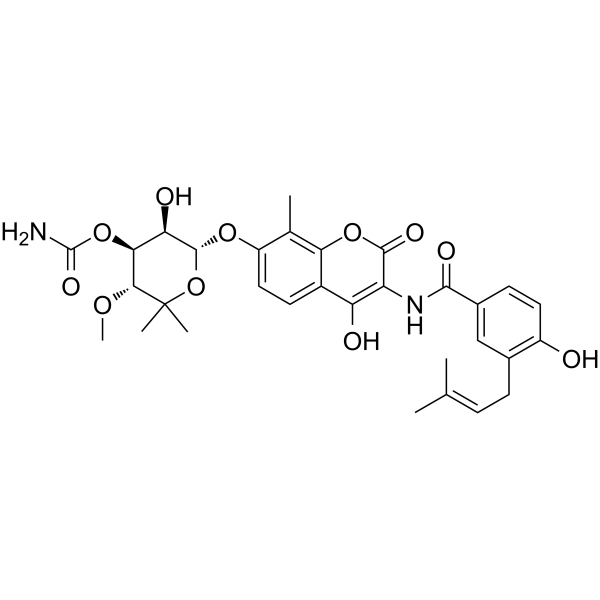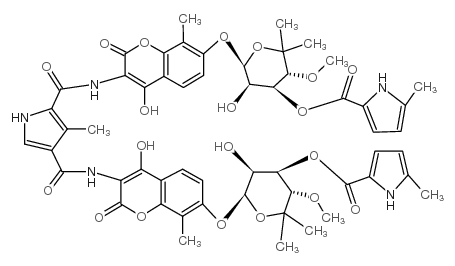CHEMICAL IDENTIFICATION
-
RTECS NUMBER :
-
CU9080000
-
CHEMICAL NAME :
-
Benzamide, N-(7-((3-O-(aminocarbonyl)-6-deoxy-5-C-methyl-4-O-met hyl-beta-L-lyxo- hexopyranosyl)oxy)-4-hydroxy-8-methyl-2-oxo-2H-1-benz opyran-3-yl)-4-hydrox y- 3-(3-methyl-2-butenyl)-
-
CAS REGISTRY NUMBER :
-
303-81-1
-
LAST UPDATED :
-
199410
-
DATA ITEMS CITED :
-
20
-
MOLECULAR FORMULA :
-
C31-H36-N2-O11
-
MOLECULAR WEIGHT :
-
612.69
-
WISWESSER LINE NOTATION :
-
T66 BOVJ DMVR DQ C2UY1&1& EQ J1 IO- FT6OTJ B1 B1 CV1 DOVZ EQ &-NA-
HEALTH HAZARD DATA
ACUTE TOXICITY DATA
-
TYPE OF TEST :
-
TDLo - Lowest published toxic dose
-
ROUTE OF EXPOSURE :
-
Unreported
-
SPECIES OBSERVED :
-
Human
-
DOSE/DURATION :
-
171 mg/kg/12D-C
-
TOXIC EFFECTS :
-
Sense Organs and Special Senses (Eye) - conjunctive irritation Skin and Appendages - dermatitis, other (after systemic exposure)
-
TYPE OF TEST :
-
LD50 - Lethal dose, 50 percent kill
-
ROUTE OF EXPOSURE :
-
Oral
-
SPECIES OBSERVED :
-
Rodent - mouse
-
DOSE/DURATION :
-
1500 mg/kg
-
TOXIC EFFECTS :
-
Details of toxic effects not reported other than lethal dose value
-
TYPE OF TEST :
-
LD50 - Lethal dose, 50 percent kill
-
ROUTE OF EXPOSURE :
-
Intraperitoneal
-
SPECIES OBSERVED :
-
Rodent - mouse
-
DOSE/DURATION :
-
262 mg/kg
-
TOXIC EFFECTS :
-
Details of toxic effects not reported other than lethal dose value
-
TYPE OF TEST :
-
LD50 - Lethal dose, 50 percent kill
-
ROUTE OF EXPOSURE :
-
Intravenous
-
SPECIES OBSERVED :
-
Rodent - mouse
-
DOSE/DURATION :
-
407 mg/kg
-
TOXIC EFFECTS :
-
Details of toxic effects not reported other than lethal dose value
-
TYPE OF TEST :
-
Cytogenetic analysis
MUTATION DATA
-
TYPE OF TEST :
-
Sister chromatid exchange
-
TEST SYSTEM :
-
Rodent - hamster Ovary
-
DOSE/DURATION :
-
200 mg/L
-
REFERENCE :
-
CHROAU Chromosoma. (Springer-Verlag New York, Inc., Service Center, 44 Hartz Way, Secaucus, NJ 07094) V.1- 1939- Volume(issue)/page/year: 85,603,1982
|



 CAS#:1445875-24-0
CAS#:1445875-24-0 CAS#:1476-53-5
CAS#:1476-53-5 CAS#:4434-05-3
CAS#:4434-05-3